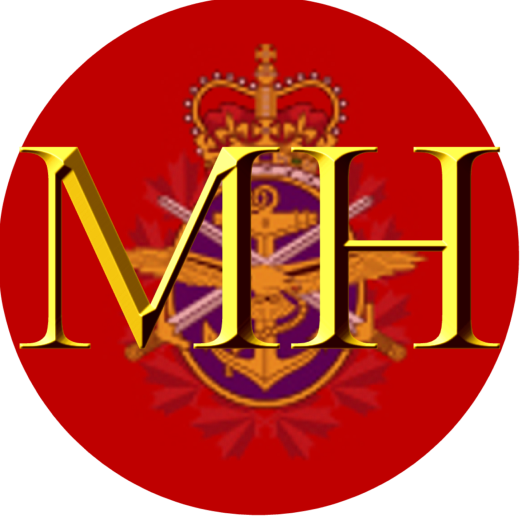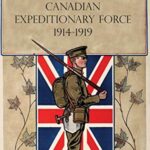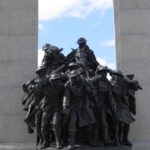The Canadian Military in the Korean War: A Comprehensive Survey
When the Korean War erupted in June 1950, the world was barely five years removed from the devastation of the Second World War. For Canada, it was a conflict fought far from home, on a peninsula most Canadians had little familiarity with, but it quickly became a critical test of the country’s role on the global stage. As part of a multinational coalition under the United Nations (UN), Canada’s involvement in the Korean War underscored its emergence as a middle power, deeply committed to the principles of collective security and international peacekeeping. This essay will explore the conditions in Canada before the war, the origins of the conflict, Canada’s reaction to the outbreak of war, the mobilization of Canadian forces, a survey of Canadian military participation within the UN alliance, the political context of the war, areas of military commitment, the home front reaction, and the development of the Canadian Armed Forces as a result of this experience.
Pre-War Conditions in Canada
The years immediately following the Second World War were a period of transition for Canada. Having contributed significantly to the Allied victory, Canada had emerged with one of the largest navies in the world, a highly respected air force, and a well-trained army. The country’s economy had also benefited from wartime production, making Canada one of the most industrialized nations by 1945. Yet, as peace returned, the government embarked on a rapid process of demobilization. Canada’s military, which had swelled to over a million men and women during the war, was dramatically downsized. By 1950, the Canadian Armed Forces consisted of around 20,000 active soldiers, a modest navy, and an air force that had been scaled back.
Politically, Canada was solidifying its position as a middle power. Its foreign policy had evolved significantly, from a colony under British control to an independent player in international diplomacy. Canada had joined the newly formed United Nations in 1945 and was a founding member of the North Atlantic Treaty Organization (NATO) in 1949. Canada’s foreign policy was deeply tied to its commitment to multilateralism, collective security, and peacekeeping, principles which would define its participation in the Korean War.
Despite the economic prosperity and newfound influence, Canada, like much of the Western world, was ill-prepared for another military conflict. The memories of the Second World War were still fresh, and the country was focused on rebuilding its infrastructure, economy, and social services. The global landscape, however, was rapidly changing. The Cold War between the United States and the Soviet Union was intensifying, and Canada, geographically positioned between these two superpowers, found itself drawn into the geopolitical struggle.
Why the Korean War Started
The Korean War was a direct result of the post-World War II division of Korea and the growing tension between the communist and capitalist blocs. Korea had been under Japanese occupation from 1910 until the end of the Second World War, after which the country was liberated by the Allies. The peninsula was divided along the 38th parallel, with Soviet forces occupying the north and American forces occupying the south. The division was meant to be temporary, but as the Cold War deepened, it became clear that Korea would remain split between two ideologically opposed governments.
In 1948, the northern part of the peninsula became the Democratic People’s Republic of Korea (North Korea) under Kim Il-sung, with strong support from the Soviet Union and, later, the People’s Republic of China. The southern part became the Republic of Korea (South Korea) under Syngman Rhee, supported by the United States and other Western powers. Both leaders claimed to be the legitimate ruler of the entire Korean Peninsula, and tensions between the two Koreas simmered throughout the late 1940s.
On June 25, 1950, North Korean forces, equipped with Soviet-made tanks, artillery, and aircraft, launched a surprise invasion of South Korea. The North Korean People’s Army (KPA) quickly overwhelmed the South Korean defenses, and within days, they had captured Seoul, the capital of South Korea. The invasion was viewed by the United States and its Western allies as part of a broader communist strategy to expand influence in Asia, and President Harry S. Truman saw the invasion as a test of Western resolve.
The United Nations Security Council, with the Soviet Union absent due to a boycott, passed a resolution calling for an international military response to repel the North Korean invasion and restore peace. This marked the first time the UN had authorized military action, and it set the stage for a global coalition to intervene in Korea. The United States took the lead in organizing the military response, but many other nations, including Canada, would soon contribute troops to the effort.
Canada’s Reaction to the Outbreak of War
In Canada, the initial response to the outbreak of the Korean War was cautious. The country had just endured the long and grueling years of the Second World War, and there was little appetite for another military conflict. However, the ideological context of the Cold War, combined with Canada’s commitment to multilateralism and collective security, made it difficult for the government to remain on the sidelines.
Prime Minister Louis St. Laurent, a pragmatic and experienced leader, was initially reluctant to commit Canadian troops to the conflict. He and his government were focused on rebuilding the economy and addressing domestic concerns, and the war in Korea seemed distant and unrelated to Canada’s immediate interests. However, St. Laurent recognized that Canada, as a founding member of the United Nations, had a responsibility to uphold the principles of international peace and security. Furthermore, Canada’s close relationship with the United States, its primary trading partner and military ally, made participation in the UN’s first major military action almost inevitable.
On June 29, 1950, just four days after the North Korean invasion, Canada committed three destroyers from the Royal Canadian Navy (RCN) to support the United Nations effort in Korea. HMCS Cayuga, HMCS Athabaskan, and HMCS Sioux were deployed to Korean waters, where they would assist in naval operations, including escorting convoys, conducting patrols, and providing gunfire support for ground troops.
While this initial naval commitment demonstrated Canada’s support for the UN mission, it was a relatively modest contribution. However, as the situation in Korea deteriorated and the United States called for greater international support, pressure mounted on Canada to send ground troops. By August 1950, Canada had agreed to form an infantry brigade for service in Korea. This marked the beginning of Canada’s full-scale military involvement in the Korean War.
Mobilization of Canadian Forces
The mobilization of Canadian forces for the Korean War was a significant challenge, given the state of the country’s military in 1950. After the rapid demobilization that followed the Second World War, the Canadian Army had been reduced to a peacetime force of approximately 20,000 personnel. While the core of the army remained well-trained, it was not immediately prepared for large-scale overseas deployment. Canada had to quickly reorganize and expand its military capabilities to meet the demands of the Korean conflict.
The 2nd Battalion, Princess Patricia’s Canadian Light Infantry (PPCLI) was the first Canadian unit to be mobilized for Korea. The PPCLI, one of Canada’s most storied regiments, had served with distinction during both World Wars, and its soldiers were known for their professionalism and discipline. The 2nd Battalion, which had been reactivated in 1948 as part of Canada’s post-war military restructuring, was rapidly deployed to Korea in December 1950.
As the war continued, Canada expanded its military commitment, forming the 25th Canadian Infantry Brigade, which included the Royal Canadian Regiment (RCR), the Royal 22e Régiment (Van Doos), and the PPCLI, along with supporting artillery, engineers, and logistical units. This brigade would eventually be integrated into the 1st Commonwealth Division, which included forces from the United Kingdom, Australia, New Zealand, and other Commonwealth nations. The Canadian Army’s participation in Korea was characterized by its professionalism and the experience many of its soldiers had gained during the Second World War.
Canadian Military Participation within the United Nations Alliance
Canada’s military participation in the Korean War was conducted under the banner of the United Nations, marking a new era in the country’s military history. Unlike previous conflicts, where Canada had fought as part of the British Empire, the Korean War was a multilateral effort, with troops from 16 nations fighting to repel North Korean and Chinese forces. Canada’s participation was driven by its commitment to the principles of collective security, as enshrined in the UN Charter, and its desire to support international peace.
Canadian soldiers quickly found themselves involved in some of the most intense fighting of the war. One of the defining moments of Canada’s participation in the Korean War came during the Battle of Kapyong in April 1951. At Kapyong, the 2nd Battalion, Princess Patricia’s Canadian Light Infantry, along with Australian and New Zealand forces, held a critical position on the hills overlooking the Kapyong Valley. The UN forces were tasked with blocking a major Chinese offensive aimed at cutting off the retreat of South Korean and American forces.
For two days, the Canadians endured relentless attacks from Chinese forces, who outnumbered them by a significant margin. The battle was fought in difficult terrain, with the Canadians holding their positions despite being surrounded and running low on ammunition. The successful defense of Kapyong prevented the collapse of the UN line and earned the PPCLI the United States Presidential Unit Citation, a rare honor for non-American troops. The battle cemented Canada’s reputation as a capable and determined fighting force, and it remains one of the most celebrated engagements in Canadian military history.
Throughout the war, Canadian forces participated in both defensive and offensive operations. They were involved in Operation Commando in October 1951, a major UN offensive aimed at securing key positions along the Jamestown Line, near the 38th parallel. Canadian infantry and artillery units played a critical role in the success of this operation, which helped stabilize the front lines and set the stage for the eventual ceasefire negotiations.
The war in Korea was characterized by a combination of fast-moving offensives and long periods of static trench warfare. The terrain, which included rugged mountains and deep valleys, made combat difficult, and the weather—ranging from hot, humid summers to freezing winters—added to the challenges faced by the troops. Canadian soldiers, drawing on their experiences from the Second World War, adapted well to these conditions and were frequently praised for their resilience and discipline.
In addition to their combat roles, Canadian forces were also heavily involved in peacekeeping and reconstruction efforts. As the front lines stabilized and the war transitioned into a stalemate, Canadian soldiers helped rebuild infrastructure, provided medical assistance to civilians, and worked to improve living conditions for the South Korean population. This humanitarian aspect of the Canadian mission reflected the broader goals of the United Nations, which sought not only to repel the North Korean invasion but also to support the recovery and stability of South Korea.
The Politics of the Canadian Military Forces in Relation to the War
The Korean War presented a new set of political challenges for Canada. Unlike the world wars, where Canada had fought as part of the British Empire, the Korean War was framed as part of a broader international effort under the United Nations. Canada’s participation was driven by its commitment to collective security, a principle that had gained prominence in the post-World War II world order. Prime Minister Louis St. Laurent and his government viewed the Korean conflict as a critical test of the UN’s ability to enforce international peace and prevent the spread of communism.
However, there were also domestic political considerations that influenced Canada’s approach to the war. While there was general support for the UN mission, there were concerns about becoming too entangled in the broader Cold War rivalry between the United States and the Soviet Union. St. Laurent was careful to frame Canada’s involvement as part of a UN-led peacekeeping effort, rather than as a direct confrontation between the capitalist and communist blocs. This distinction was important for maintaining public support at home and for preserving Canada’s reputation as a peacekeeping nation.
Canada’s relationship with the United States was also a key factor in its decision to participate in the Korean War. While Canada had historically maintained close ties with Britain, the post-war period saw a shift in Canadian foreign policy, with the United States becoming Canada’s most important military and economic partner. The Korean War, which was largely led and financed by the United States, underscored the growing alignment between Canada and its southern neighbor. However, St. Laurent and his foreign minister, Lester B. Pearson, were careful to maintain Canada’s independence within the UN alliance, ensuring that Canada’s participation was seen as part of a multilateral effort rather than simply following American policy.
Areas of Military Commitment
Canadian forces were primarily committed to the defense of strategic positions along the front lines in Korea, particularly in the central and eastern sectors of the 38th parallel. The 25th Canadian Infantry Brigade was integrated into the 1st Commonwealth Division, which operated alongside American and South Korean forces. Canadian troops were involved in key battles, including Kapyong and Operation Commando, and were tasked with holding defensive positions, conducting patrols, and launching counterattacks against Chinese and North Korean forces.
The Royal Canadian Navy also played a significant role in the war. Canadian destroyers, including HMCS Cayuga, HMCS Athabaskan, and HMCS Sioux, were deployed to Korean waters, where they conducted a variety of missions, including escorting supply convoys, providing naval gunfire support for ground forces, and patrolling the coast to prevent North Korean infiltration. The RCN’s participation in the war highlighted Canada’s ability to project naval power far from home, and it reinforced the importance of the navy in Canada’s post-war military strategy.
The Royal Canadian Air Force (RCAF), while not as heavily involved in the Korean War as the army or navy, provided logistical support and participated in airlift operations. Canadian pilots also served with UN Command in various roles, including reconnaissance, transport, and medical evacuation. Although Canada did not deploy fighter or bomber squadrons to Korea, the RCAF’s contributions to the war effort were critical in maintaining the UN’s supply lines and ensuring the mobility of troops and equipment.
Home Front Reaction to the War
The Korean War did not evoke the same level of public enthusiasm or mobilization as the two world wars, but it nonetheless had a significant impact on the Canadian home front. Canadians were initially hesitant about the conflict, given the recent memories of the Second World War and the desire to avoid another prolonged and bloody war. However, as the war progressed, public support for Canada’s participation grew, especially as the narrative shifted to emphasize the defense of democracy and international peace.
The government’s decision to rely on volunteer forces, rather than imposing conscription, helped to maintain political stability. Unlike the conscription crises of the First and Second World Wars, which had deeply divided the country, particularly between English and French Canadians, the Korean War did not lead to significant domestic strife. Most Canadians viewed the war as a necessary commitment to upholding the principles of the United Nations, and there was widespread support for Canada’s role in the international community.
On the economic front, the war led to an increase in defense spending and contributed to the continued growth of Canada’s industrial sector. Factories that had produced war materials during the Second World War were reactivated to supply equipment for the Korean conflict, and the Canadian economy benefited from the increased demand for military goods. The war also provided employment opportunities for veterans and young Canadians, many of whom enlisted in the newly reformed military.
The Development of Canadian Armed Forces
The Korean War had a lasting impact on the development of Canada’s armed forces. In the years following the Second World War, the Canadian military had undergone significant downsizing, but the Korean conflict highlighted the need for a well-trained and well-equipped standing army capable of rapid deployment. The experience gained in Korea helped professionalize the Canadian military and reinforced the importance of maintaining a strong defense force during the Cold War.
The war also demonstrated the value of multilateral military cooperation, particularly within the framework of the United Nations. Canada’s participation in the Korean War marked the beginning of its long-standing role as a contributor to UN peacekeeping missions, a role that would become a cornerstone of Canadian foreign policy in the decades to come. The war also solidified Canada’s military relationship with the United States, particularly within the context of NATO and the broader Cold War alliance.
Conclusion: Canada’s Legacy in the Korean War
The Korean War was a defining moment for Canada’s military and its role on the global stage. While the conflict may not have garnered the same attention or left the same lasting impact as the two world wars, Canada’s contributions to the UN effort in Korea were significant. Canadian soldiers, sailors, and airmen distinguished themselves in battle, earning a reputation for professionalism, resilience, and bravery.
For Canada, the Korean War marked a shift in its military and foreign policy. No longer simply a junior partner within the British Empire, Canada had emerged as an independent middle power, deeply committed to multilateralism, collective security, and peacekeeping. The war also reinforced the importance of maintaining a strong and capable military, even in peacetime, as the global landscape of the Cold War continued to evolve.
The legacy of the Korean War lives on in Canada’s military traditions, its international diplomacy, and its continued commitment to upholding peace and security around the world.



